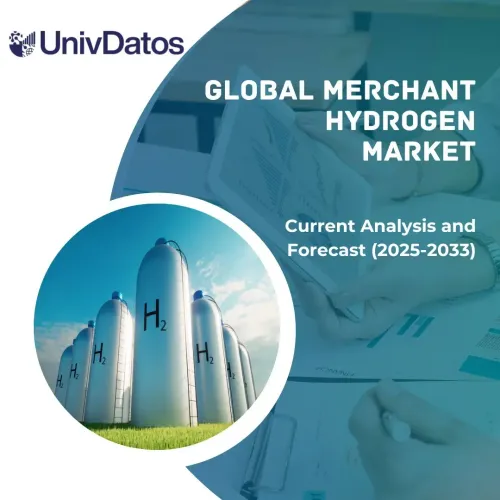- Home
- About Us
- Industry
- Services
- Reading
- Contact Us
Carbon Capture and Sequestration Market: Current Analysis and Forecast (2023-2030)
Emphasis on Service (Capture (Combustion, Industrial Separation), Transport, Sequestration); Capture Source (Chemicals Production, Natural Gas Processing, Power Generation, Fertilizers Production, Others); Storage Category (EOR and Dedicated Geological Storage); Region and Country
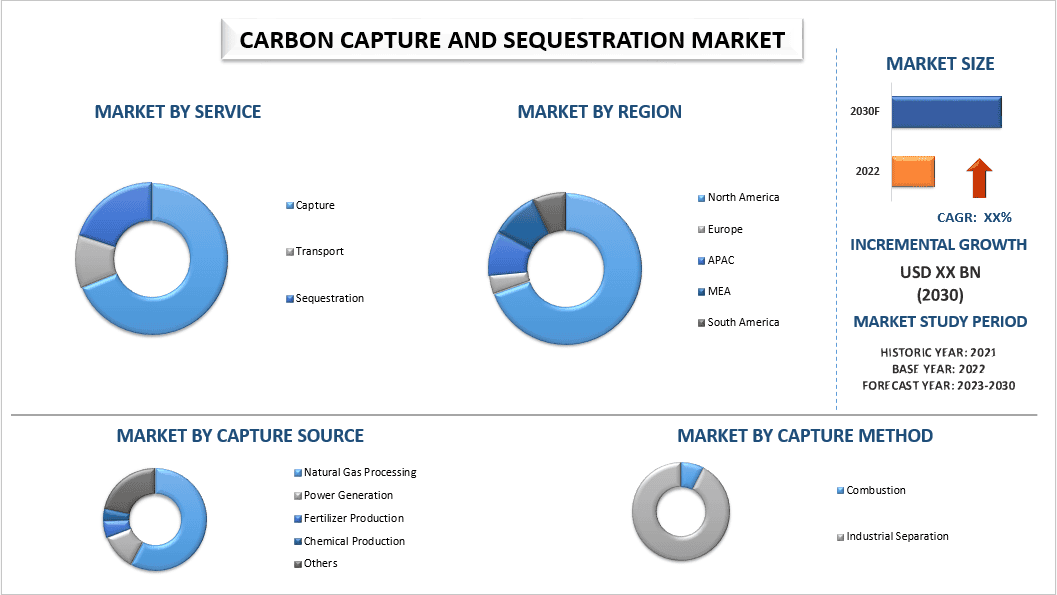
The Global Carbon Capture and Sequestration Market is expected to grow at a CAGR of 22.8% from 2023-2030 to reach USD 10,368.7 million by 2030.Human emissions of carbon dioxide and other greenhouse gases are a major driver for climate change globally, it acts as one of the major challenges for the global economy. Owing to this in the past few decades, globally the average temperatures have increased to approximately 0.7℃ higher than 1961-1990 baseline. Carbon capture and storage (CCS), refers to the process of capturing carbon dioxide (CO2) from anthropogenic sources such as power generation and/or industrial processes) and permanently storing the captured CO2 underground, to prevent excess emissions of CO2 from entering the atmosphere. This is considered as an integral component of achieving decarbonization. The United States Department of Energy (DOE)’s National Energy Technology Laboratory (NETL) have been spending heavily on R&D related CCS for nearly two decades. As per International Energy Agency data for 2019, globally, roughly 33 million metric tons of CO2 (MtCO2) is being captured and stored each year (mostly as part of enhanced oil recovery [EOR]). However, as per energy outlook analyses, to meet the emission target, it is estimated that CCS would be needed on the scale of upwards of 1,500 MtCO2 being captured per year by 2030 and between 5,000-10,000 MtCO2 being captured per year by 2050.
Comparative Analysis, CCUS Readiness Level across UNECE Region
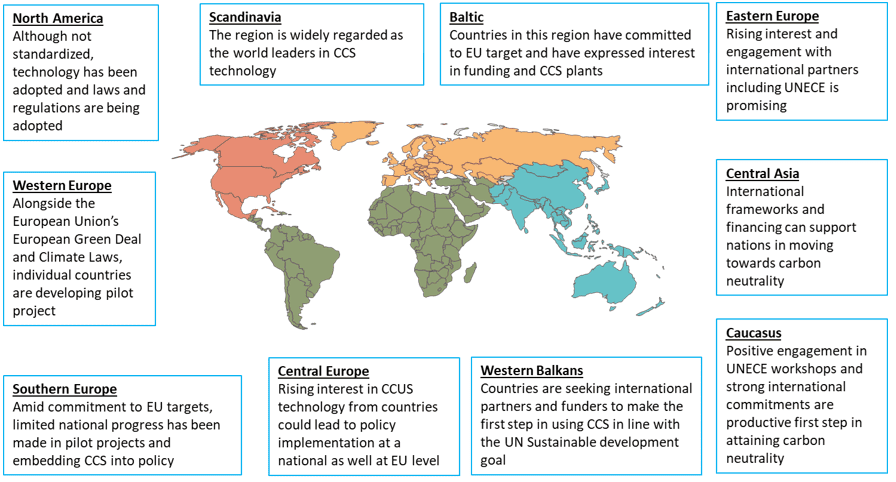
Insights Presented in the Report
“Amongst Service, Carbon Capture service segment dominated the market in 2022.”
Based on service the Global Carbon Capture and Sequestration Market is categorized into Capture (combustion and industrial separation), Transport, Sequestration. Currently, Carbon Capture segment dominate the market in revenue share and is expected to maintain its dominance during the forecast period.
“Amongst Capture source, Natural Gas Processing and Power Generation generated major portion of revenue in 2022.”
Based on capture source, the Global Carbon Capture and Sequestration Market is bifurcated into Chemicals, Natural Gas Processing, Power Generation, Fertilizers Production, Others. Among these, natural gas processing and power generation together captured a significant revenue share in 2022.
“Amongst Storage, EOR Process category generated highest revenue in 2022.”
Based on storage, the Global Carbon Capture and Sequestration Market is bifurcated into EOR and dedicated geological storage. Currently, EOR segment dominated the market. However, dedicated geological storage is likely to capture the top position in the market by 2030.
Carbon Capture and Sequestration Market Report Coverage
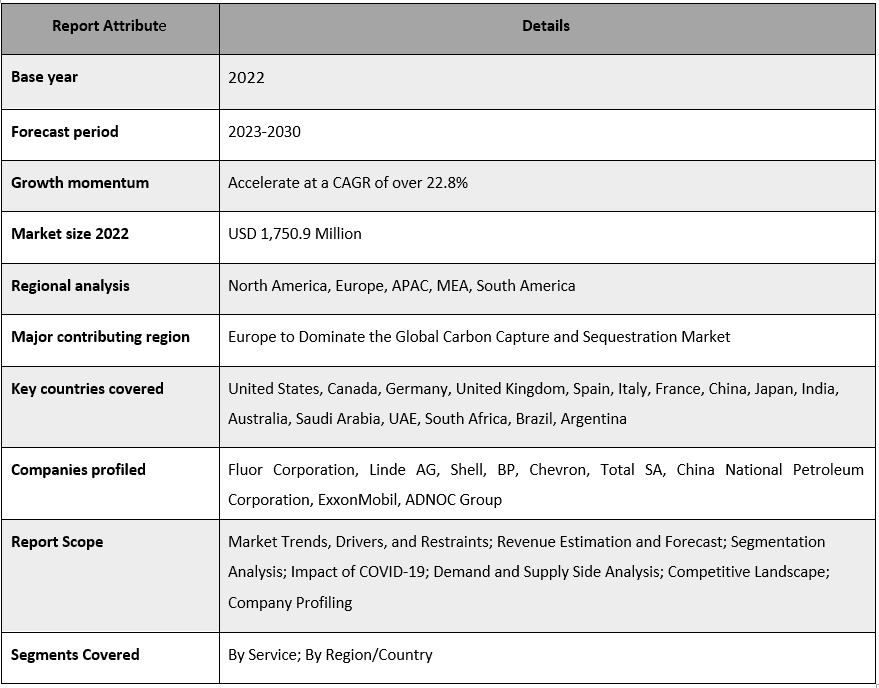
“North America represents as the largest markets in the Global Carbon Capture and Sequestration Market.”
For a better understanding of the market adoption, report provide detailed analysis for major region and countries including North America (US, Canada), Europe (Germany, France, UK, Italy, Spain), Asia-Pacific (China, India, Japan, Australia), Middle East & Africa (South Africa, UAE, Saudi Arabia), and South America (Brazil, Argentina). North America dominated the market in 2020, however, Europe is likely to showcase fastest growth rate owing to increasing number of carbon capture projects in Europe due to increasing concern regarding greenhouse emission. Some of the major players operating in the market include Fluor Corporation, Linde AG, Shell, Equinor, Chevron, TotalEnergies, Petrobras, China National Petroleum Corporation, ExxonMobil, ADNOC Group.
Reasons to buy this report:
- The study includes market sizing and forecasting analysis validated by authenticated key industry experts
- The report presents a quick review of overall industry performance at one glance
- The report covers in-depth analysis of prominent industry peers with a primary focus on key business financials, product portfolio, expansion strategies, and recent developments
- Detailed examination of drivers, restraints, key trends, and opportunities prevailing in the industry
- The study comprehensively covers the market across different segments
- Deep dive country level analysis of the industry
Customization Options:
The Global Carbon Capture and Sequestration Market can further be customized as per the requirement or any other market segment. Besides this, UMI understands that you may have your own business needs, hence feel free to connect with us to get a report that completely suits your requirements.
Table of Content
Research Methodology for Global Carbon Capture and Sequestration Market Analysis (2023-2030)
Analyzing the historical market, estimation of the current market, and forecasting the future of the Global Carbon Capture and Sequestration Market were the three major steps undertaken to create and analyze the adoption of Carbon Capture and Sequestration technique across various end-use sector globally. Exhaustive secondary research was conducted to collect the historical market numbers and estimate the current market size. Secondly, to validate these insights, numerous findings and assumptions were taken into consideration. Moreover, exhaustive primary interviews were also conducted, with industry experts across the value chain of the global Carbon Capture and Sequestration industry. Post assumption and validation of market numbers through primary interviews, we employed a bottom-up approach to forecast the complete market size. Thereafter, market breakdown and data triangulation methods were adopted to estimate and analyze the market size of segments and sub-segments the industry pertains to. Detailed methodology is explained below:
Analysis of Historical Market Size
Step 1: In-Depth Study of Secondary Sources:
Detail secondary study was conducted to obtain the historical market size of the Carbon Capture and Sequestration market through company internal sources such as annual report & financial statements, performance presentations, press releases, etc., and external sources including journals, news & articles, government publications, competitor publications, sector reports, third-party database, and other credible publications.
Step 2: Market Segmentation:
After obtaining the historical market size of the Carbon Capture and Sequestration market, we conducted a detailed secondary analysis to gather historical market insights and share for different segments & sub-segments for major regions. Major segments included in the report are service, capture source, capture method, and storage. Further regional and country-level analyses were conducted to evaluate the overall adoption of the Carbon Capture and Sequestration globally.
Step 3: Factor Analysis:
After acquiring the historical market size of different segments and sub-segments, we conducted a detailed factor analysis to estimate the current market size of Carbon Capture and Sequestration. Further, we conducted factor analysis using dependent and independent variables such as Rising number of EOR Projects to reduce Carbon Emissions, Rising Government investments on Carbon Capture technology etc. A thorough analysis was conducted for demand and supply-side scenario considering top partnerships, merger and acquisition, business expansion, and product launches in the Carbon Capture and Sequestration industry.
Current Market Size Estimate & Forecast
Current Market Sizing: Based on actionable insights from the above 3 steps, we arrived at the current market size, key players in the Global Carbon Capture and Sequestration market, and market shares of the segments. All the required percentage shares split, and market breakdowns were determined using the above-mentioned secondary approach and were verified through primary interviews.
Estimation & Forecasting: For market estimation and forecast, weights were assigned to different factors including drivers & trends, restraints, and opportunities available for the stakeholders. After analyzing these factors, relevant forecasting techniques i.e., bottom-up approach was applied to arrive at the market forecast to 2027 for different segments and subsegments across the major regions globally. The research methodology adopted to estimate the market size encompasses:
- The industry’s market size, in terms of value (US$) and the adoption rate of Carbon Capture and Sequestration across the major markets
- All percentage shares, splits, and breakdowns of market segments and sub-segments
Market Size and Share Validation
Primary Research: In-depth interviews were conducted with the Key Opinion Leaders (KOLs) including Top Level Executives (CXO/VPs, Sales Head, Marketing Head, Operational Head, and Regional Head, Country Head, etc.) across major regions. Primary research findings were then summarized, and statistical analysis was performed to prove the stated hypothesis. Inputs from primary research were consolidated with secondary findings, hence turning information into actionable insights.
Split of Primary Participants in Different Regions
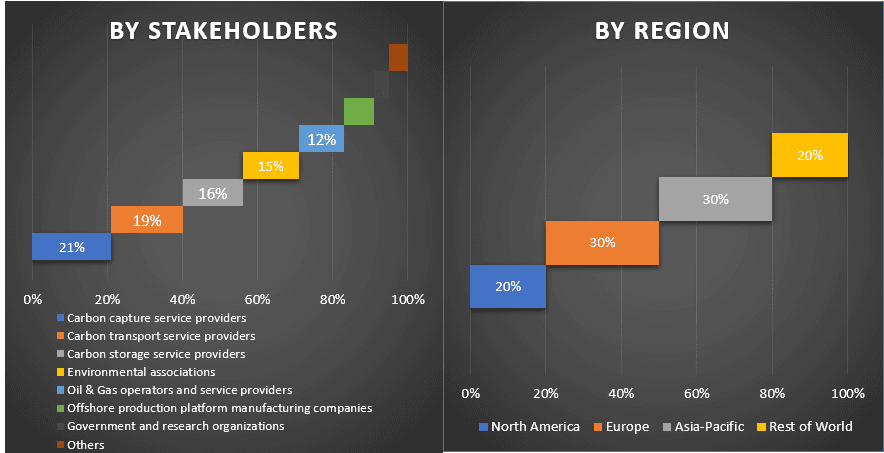
Market Engineering
Data triangulation technique was employed to complete the overall market estimation and to arrive at precise statistical numbers of each segment and sub-segment of the Global Carbon Capture and Sequestration market. Data was split into several segments & sub-segments post studying various parameters and trends in the areas of service, capture source and end-use category.
The main objective of the Carbon Capture and Sequestration Market Study
The current & future market trends of Global Carbon Capture and Sequestration were pinpointed in the study. Investors can gain strategic insights to base their discretion for investments from the qualitative and quantitative analysis performed in the study. Current and future market trends would determine the overall attractiveness of the market at a country level, providing a platform for the industrial participant to exploit the untapped market to benefit as a first-mover advantage. Other quantitative goals of the studies include:
- Analyze the current and forecast market size of Carbon Capture and Sequestration in terms of value (US$). Also, analyze the current and forecast market size of different segments and sub-segments
- Segments in the study include areas of service, capture source, capture method, and storage
- Defined analysis of the regulatory framework for the Carbon Capture and Sequestration industry
- Analyze the value chain involved with the presence of various intermediaries, along with analyzing customer and competitor behaviors of the industry
- Analyze the current and forecast market size of the Carbon Capture and Sequestration for the major countries
- Major regions/countries analyzed in the report includes North America (US, Canada), Europe (Germany, UK, France, Italy, Spain), Asia-Pacific (China, India, Japan, Australia), Middle East & Africa (South Africa, UAE, Saudi Arabia), and South America (Brazil, Argentina).
- Company profiles of the Carbon Capture and Sequestration market players and the growth strategies adopted by them to sustain in the fast-growing market
Deep dive country level analysis of the industry
Related Reports
Customers who bought this item also bought

